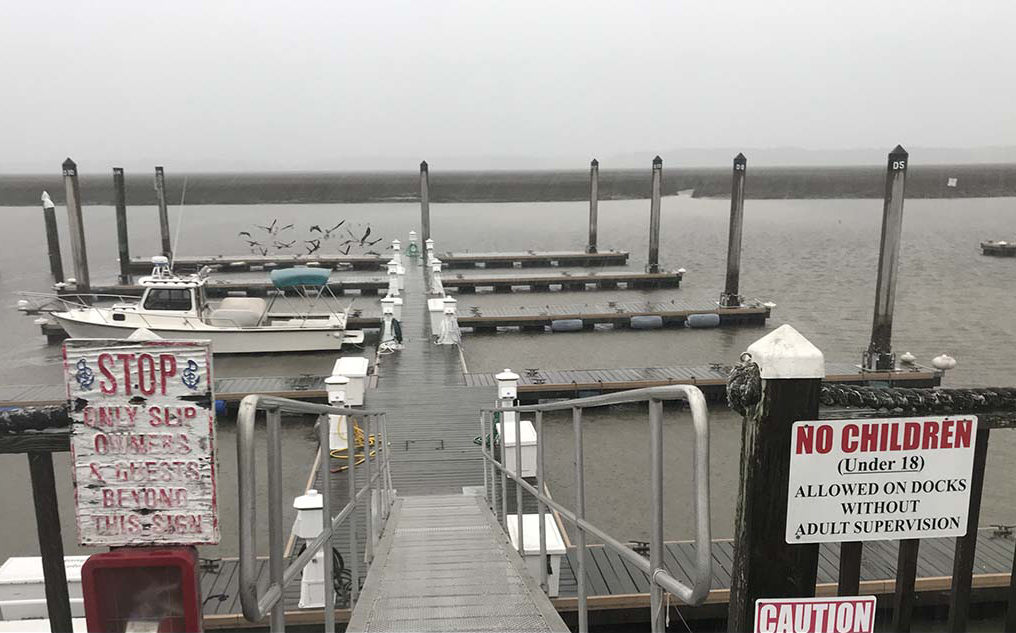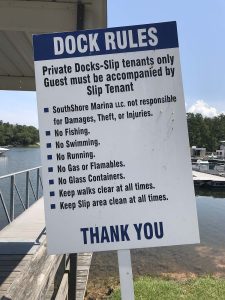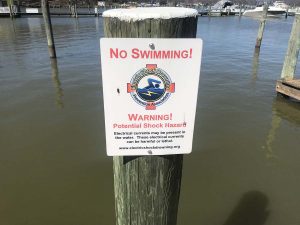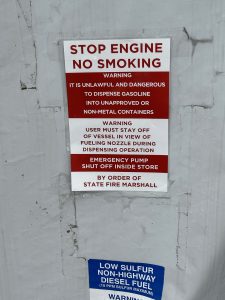
Signage and the Pivotal Role it Plays in Operating a Well-Run Marina
Published on September 30, 2025Signage might not be the first thing that comes to mind when envisioning a well-run marina, but industry experts agree it plays a pivotal role in both safety and customer experience. Knowing what to include, where to place signs, and how to design them can protect marina owners from liability and promote a safer, more organized environment.
When David Floyd, CEO of Atlantic Marine, based in Wilmington, North Carolina, and his team did some remodeling, they were left scrambling to remember the exact verbiage of signs that were removed and tossed out. That prompted Floyd to question whether there are standards for marina signage.
A Marina’s Liability
“I think signage, or a lack of signage, is one of the most important things overlooked by marinas and boatyards,” said Daniel Rutherford, director of claims and risk management of One80 Marine. “Yet they are one of the pivotal things that plaintiff counsel and juries focus on when looking at injury or property damage cases.”

“Liability can be whatever a judge or jury decides,” agreed Robert Smith, safety consultant with Fisher Phillips LLP. “Signage usually represents policy, which is good only when consistently enforced. Signage that states a prohibition to swimming in the marina offers protection only when that policy is consistently enforced.”
While marinas should focus on ways to protect visitors and minimize potential legal actions, concern for employees is also paramount. Marinas are generally required to post various federal, state and local compliance notices, particularly concerning employee rights and environmental protection.
Location and Design
Signage is the marina’s frontline communication tool. It should include operational rules as well as safety rules such as life jacket requirements. A marina’s signage should communicate clearly and concisely.
A first stop for visitors is the office, and, according to Rutherford, a sign listing marina rules should be present there.
“You should be clear on your intention, two-inch or three-inch type in red or a bold color on a white background,” he said. “It should be very easy to read and be lit at night.”

Other important signage at all dock entrances and ramps should reinforce major points of the marina’s rules and regulations.
Sign design can vary by location and leadership of a marina. A good rule of thumb is if it’s a critical safety warning, the sign needs to be large, at eye level and in a place with lots of visibility. Smaller signs can be used for secondary instructions or aesthetics.
Philosophies on design vary, but experts agree that safety signage should exclude corporate logos or branding.
“There are national standards for safety signage,” Smith said. “The designs are meant to be attention grabbers. When branded, the message can be overlooked, or it comes off as more of a suggestion.”
For other signage, Floyd believes a cohesive look sends a message.
“I believe all rules, informational and direction signage has to be branded to show the professionalism of the company,” he said, “and that we expect these things to be done.”
Material choices matter, especially in marine environments. UV-resistant, corrosion-proof materials like marine grade plastics hold up well. While a wooden sign may look charming, it won’t last in the salt or humid air.
Floyd said Atlantic Marine produced a large aluminum sign to be mounted on an available wall, which makes it easy to update. The smaller signs are typically made of poly materials.
Transient boaters present unique risks due to their unfamiliarity with the property. While seasonal customers can be educated over time, transient boaters might be at the marina for only one night, so signage must be immediately visible, digestible and intuitive.
“Size and shape are also going to be determined by distance,” Smith added. “For example, a boat approaching a fuel dock will not see a ‘No Smoking’ sign that is the size of a bumper sticker. That sign needs to be large enough to be read from 100 plus feet away.”

The NFPA 303 standard requires the lettering to be a minimum 2-inch block letter. Because some states have adopted NFPA as the fire code, this would be required by law. In other areas it is best practice.
Rules to Include
While there are many possibilities for inclusion on a rules list, each facility ultimately needs to determine what to include. In addition to signage, Rutherford and Floyd said that rules should be included in slip contracts or transient slip agreements.
“Marinas should also consider signage related to property rules,” Smith said. “This could be anything from no-wake zones to firearm prohibitions to quiet hours.”
Three specific types of signage are safety, directional and informational.
Safety Signs
Fueling a boat can be dangerous or even fatal. That is why signage at the fuel dock is vitally important.
“Nowhere in the marina or boatyard are signs more important than at the fuel dock,” Rutherford said. “While not a law, NFPA does serve as the accepted standard (for fuel dock signage), and if the proper signage and warnings are not present and a fuel fire or explosion occurs, it will be a very expensive mistake.”
“There is a requirement in NFPA 303 to label the emergency fuel shut-off switch,” Smith said. “The OSHA standard also requires fire extinguishers be marked by signage.”
Signs at the fuel dock should provide reminders about what to do before, during and after fueling. While it may seem like common sense to extinguish all smoking, it’s imperative to display reminders on visible signs. Other reminders include stopping engines, shutting off all electricity or open flames and ensuring bilge pumps have expelled vapors.
Safety signs at ramps and docks should provide information for an emergency, small or large.
“They should provide emergency contact information for police, fire, EMS and marina office or staff,” Rutherford said. “Include safety warnings, like the fact that the dock or ramp surfaces can be slippery when wet, proceed at your own risk… those sorts of things.”
Directional Signs
Signage should allow easy navigation to the main office, restaurants and shops, entrances and exits, parking areas, fueling stations, launch ramps, restrooms and showers and specific docks or slips.
“Walk your property like a first-time guest. If you miss a sign or feel confused, your visitors will, too,” Floyd said.
Informational Signs
In addition to safety protocol, these signs can include reminders about environmentally preferred practices regarding discharge of sewage, pump-out station instructions and oil spill response plan information.
Backup Plans
While physical signage is the backbone of marina communication, experts recommend supplementing signs with digital and printed alternatives. Include rules and safety guidelines in welcome packets, post them on websites, and provide QR codes that link to them. The more accessible the information, the less likely it is that someone can claim ignorance or be unaware of certain rules.
“There needs to be a balance between scaring the crap out of your business invitees and covering your rear end and your liabilities,” Rutherford said.
Marina signage is more than an operational detail. It’s a risk management tool, a legal shield and a customer service feature all in one. By investing in strategic signage, marina operators not only protect themselves but also create a safer, more welcoming environment for all who step aboard.
| Categories | |
| Tags |






